photo: @DayTripper_Jen Eden Prairie, MN
Stream ID
Purgatory Creek is identified by the Kittle number M-055-011 (NRRI, 2022) and the Minnesota Pollution Control Agency (MPCA) Hydrologic Unit code 07020012. The adjacent table summarizes the sampling sites and data listed in the MPCA surface water online database.
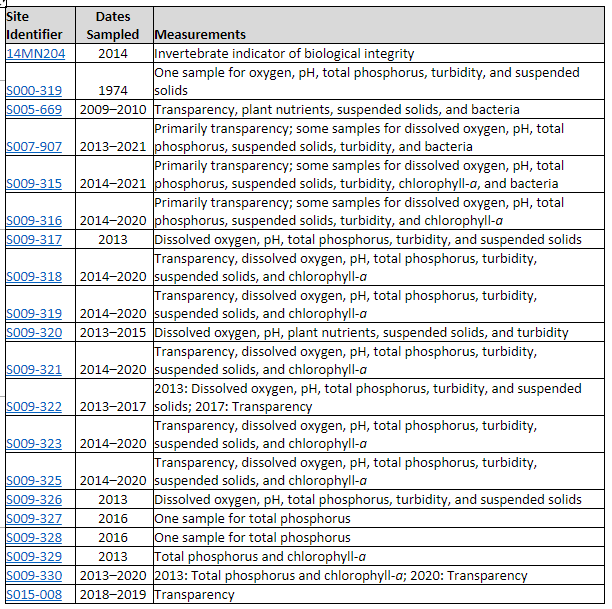
Purgatory Creek is a 12-mile-long (19-kilometer) stream located in Hennepin County that drains about 30 square miles (7,800 hectares) (RPBWD, 2021). After flowing south through lakes and communities, it empties into the Minnesota River. The watershed is 10% commercial, 57% residential, 23% open space, and 4% roads (RPBWD, 2021). Purgatory Creek is impaired for aquatic life based on benthic macroinvertebrate bioassessments and for aquatic recreation because of Escherichia coli (E. coli) bacteria (MPCA, 2022).
Many organizations collect data on Purgatory Creek. The Riley, Purgatory, Bluff Watershed District (RPBWD) samples phosphorus, sediment, pH, and dissolved oxygen at five sites during the ice-free seasons (RPBWD, 2021). The staff of the RPBWD also periodically conducts assessments of erosion and habitat along selected reaches of the creek. The Metropolitan Council of Environmental Services (MCES) samples Purgatory Creek in cooperation with the RPBWD for the Watershed Outlet Monitoring Program (MCES, 2017) downstream of Staring Lake, where the creek crosses Pioneer Trail in Eden Prairie, Minnesota, 3.9 miles upstream of the confluence with the Minnesota River. Monthly and biweekly samples have been collected year-round since 2014 at the sites designated by station ID PU0039. The measurements and analyses performed include a broad group of constituents, including major ions, trace elements, biological indicators, plant nutrients, and other indicators of stream productivity. Selected results from the analysis of samples collected from the creek are summarized in the following graphsi.
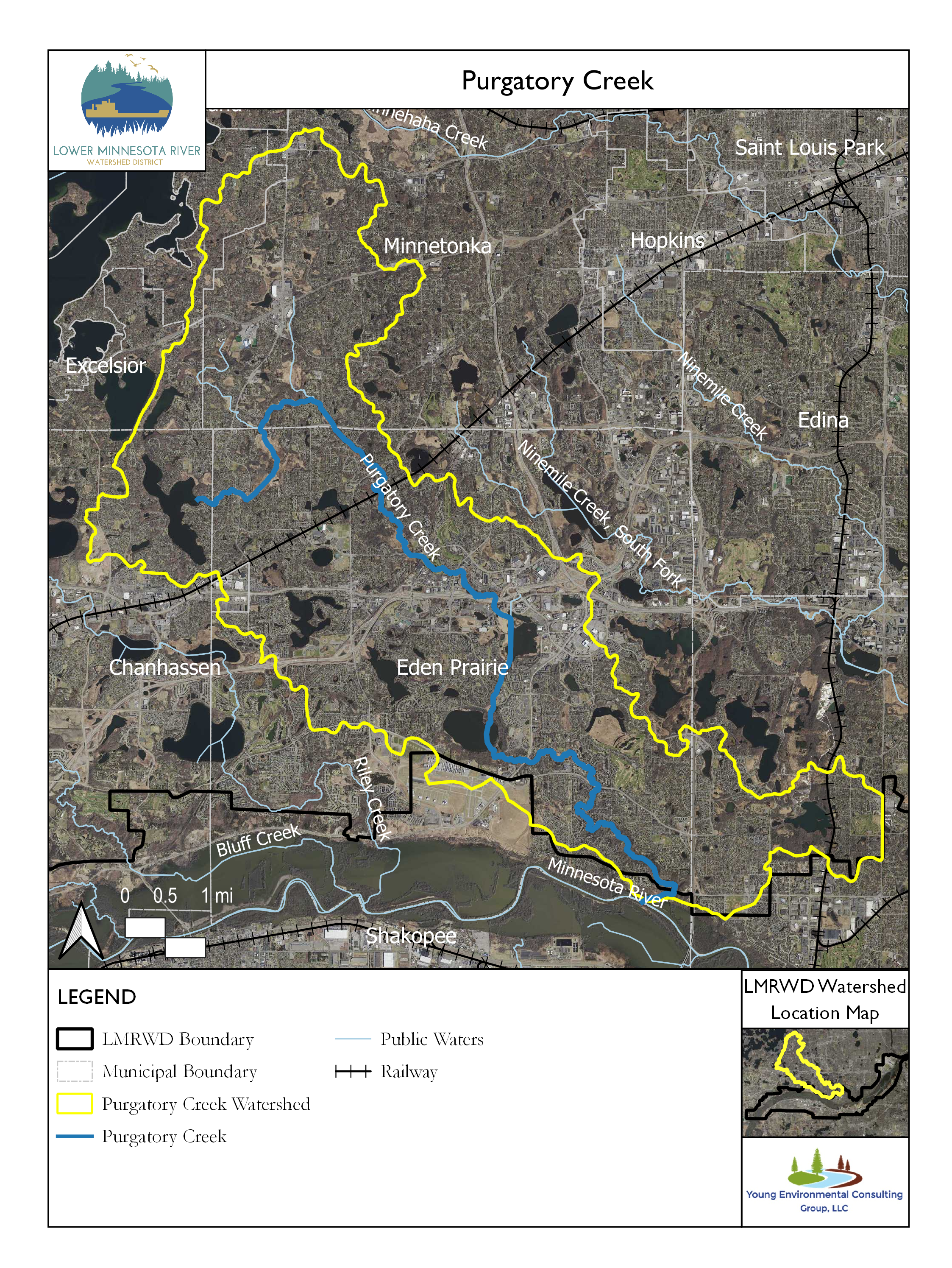
Monitoring Data
Streamflow
Sample collected from Purgatory Creek’s streamflow, the amount of water carried by the creek at the sampling site, are shown. The streamflow data are processed separately from the other data, so the streamflow measurements for 2020–21 had not been updated in the database when the data were downloaded on March 28, 2022. Staring Lake, which is upstream of the sampling site, acts like a reservoir to control the extreme flows typical of creeks this size. Streamflow of less than 2 cubic feet per second has been measured during some winters.

Water Temperature
The water temperature of Purgatory Creek is important for habitat because warmer water holds less dissolved oxygen (DO) needed by many aquatic organisms to survive. Temperatures at the sampling site fluctuate seasonally, sometimes approaching 86° Fahrenheit (30° Celsius) in the summer and near 32° F (0° C) in the winter.

Dissolved Oxygen
DO concentration measurements show that Purgatory Creek remains well oxygenated. Aquatic animals typically need at least 5 milligrams per liter (mg/L) of DO (MNDNR, 2021). Seasonal fluctuations are normal because oxygen solubility changes with the water temperature.
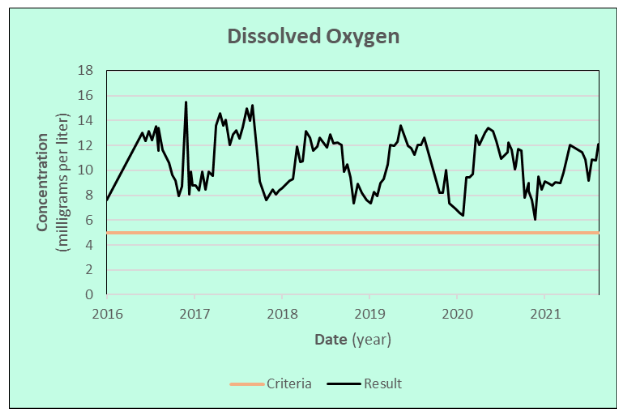
Chloride
Chloride, a primary component of road deicing and water-softening salt, represents a growing concern for many streams and lakes. The chronic standard for chloride in Minnesota waters to protect cool- and warm-water fisheries is 230 mg/L (MPCA 2018).
The adjacent chart shows the Purgatory Creek chloride concentrations since routine sampling began in 2014. Concentrations are usually well below the 230 mg/L criteria. Peak concentrations usually occur in the winter.
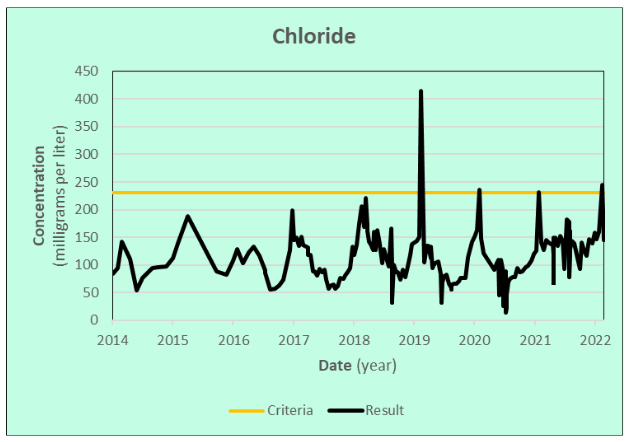
Phosphorus
Phosphorus is an essential plant nutrient that is carried by streams. Naturally occurring phosphorus concentrations may be enriched from animal waste and fertilizers, and phosphorus is often introduced with runoff. It is often associated with sediment but is more available to plants when dissolved in the water. The adjacent charts show the phosphorus concentrations in samples from Purgatory Creek. The first chart shows the total amount of phosphorus in the water, including the part associated with suspended sediment and other particulate matter. The second chart shows the phosphorus remaining in the water after the sample has been filtered to remove the sediment-associated phosphorus.
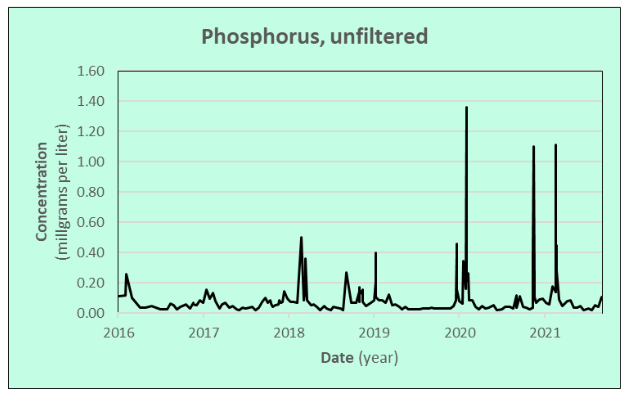
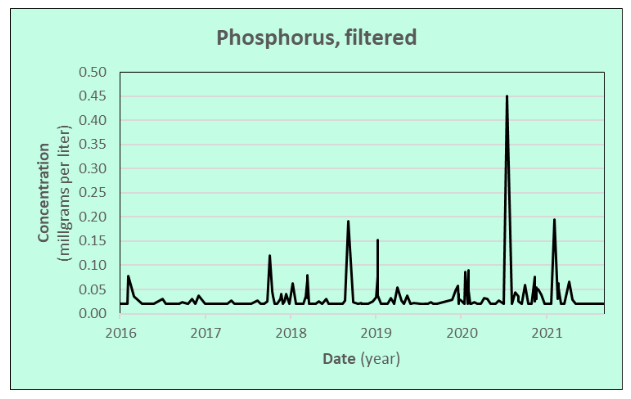
Escherichia Coli
E. coli is an organism whose levels are measured to determine the amount of fecal contamination in lakes and streams. Swimming in or ingesting water with high levels of E. coli could result in illness. The allowable limit is a monthly average of less than 126 colony-forming units per 100 milliliters of water between April and October (MPCA 2021). Purgatory Creek often has levels of E. coli that exceed the allowable limit for recreational and human health.
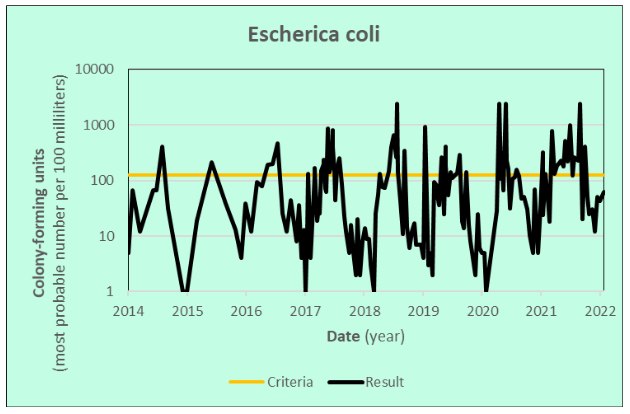
References
MCES. (2017). Joint Powers Agreement with the Minnesota Pollution Control Agency for the Watershed Outlet Monitoring Program. St. Paul, MN: Metropolitan Council Environmental Services. Retrieved March 31, 2022, from https://metrocouncil.org/Council-Meetings/Committees/Metropolitan-Council/2017/12-13-17/1213_2017_288-SW.aspx
MNDNR. (2021). Stream basics | Minnesota DNR. Retrieved November 3, 2021, from https://www.dnr.state.mn.us/fishing/trout_streams/stream_basics.html
MPCA. (2018, May 18). TCMA Chloride TMDL—Applicable Water Quality Standards and Numeric Water Quality Targets. Retrieved November 8, 2021, from https://stormwater.pca.state.mn.us/index.php/TCMA_Chloride_TMDL_-_Applicable_Water_Quality_Standards_and_Numeric_Water_Quality_Targets
MPCA. (2021, Jan). Water quality and bacteria frequently asked questions. St. Paul, MN: Minnesota Pollution Control Agency. Retrieved March 31, 2022, from https://www.pca.state.mn.us/sites/default/files/wq-s1-93.pdf
MPCA. (2022, April). Minnesota’s Impaired Waters List. (M. P. Agency, Producer) Retrieved June 21, 2022, from Impaired Waters: Draft 2022, https://www.pca.state.mn.us/water/minnesotas-impaired-waters-list
NRRI. (2022). Minnesota Natural Resources Atlas. (N. R. Institute, Producer) Retrieved March 23, 2022, from https://mnatlas.org/
RPBWD. (2021). Purgatory Creek 2021 Update. Chanhassen, MN: Riley Purgatory Bluff Watershed District. Retrieved June 27, 2022, from https://rpbcwd.org/application/files/6716/5099/5616/Fact_sheet_2021__Purgatory_Creek.pdf
This data was last updated April 2022.